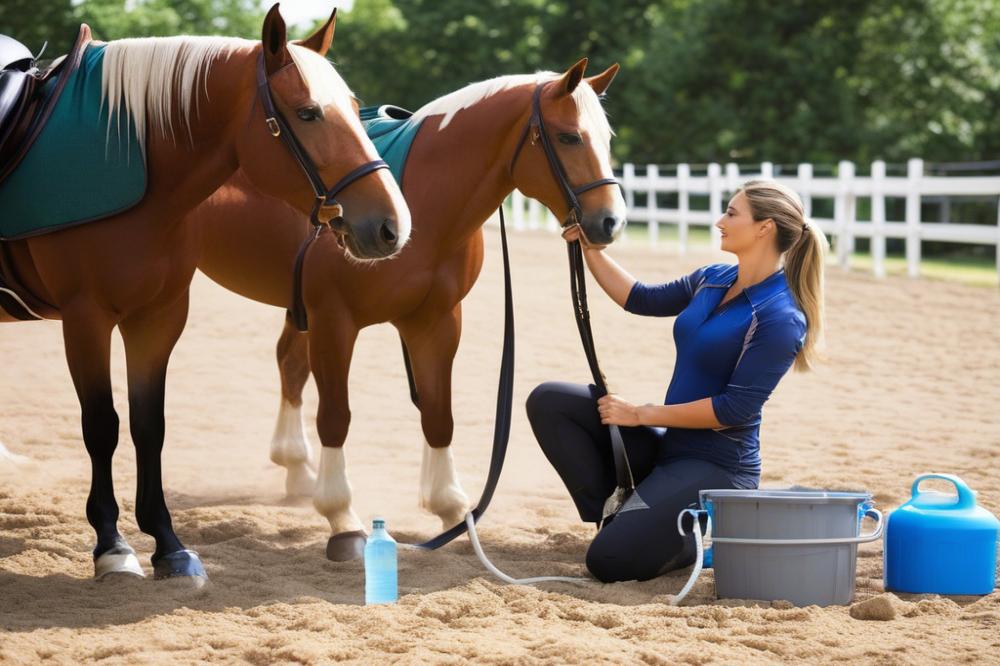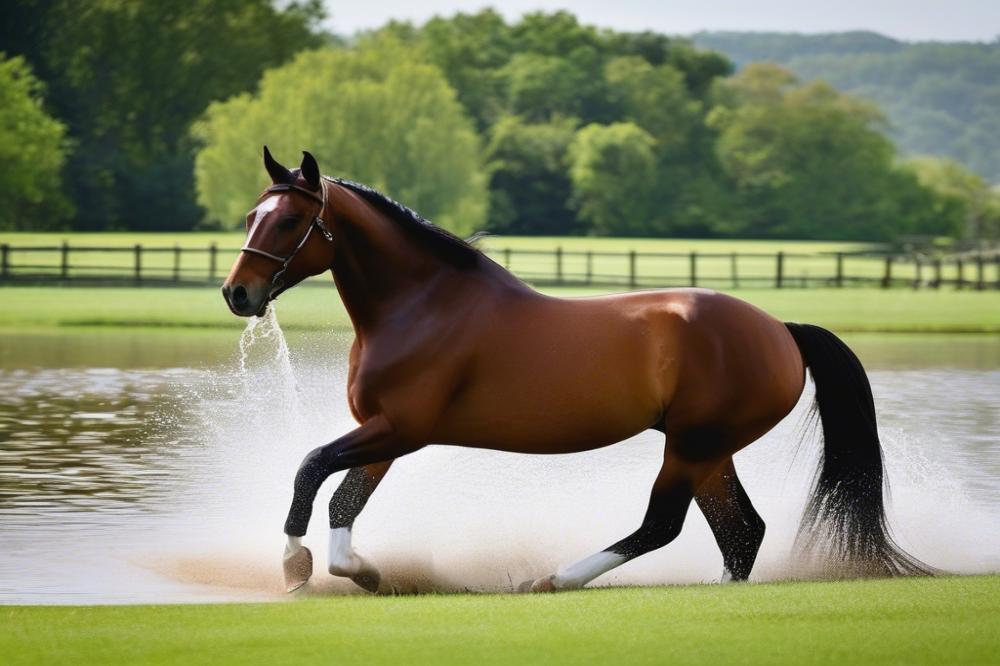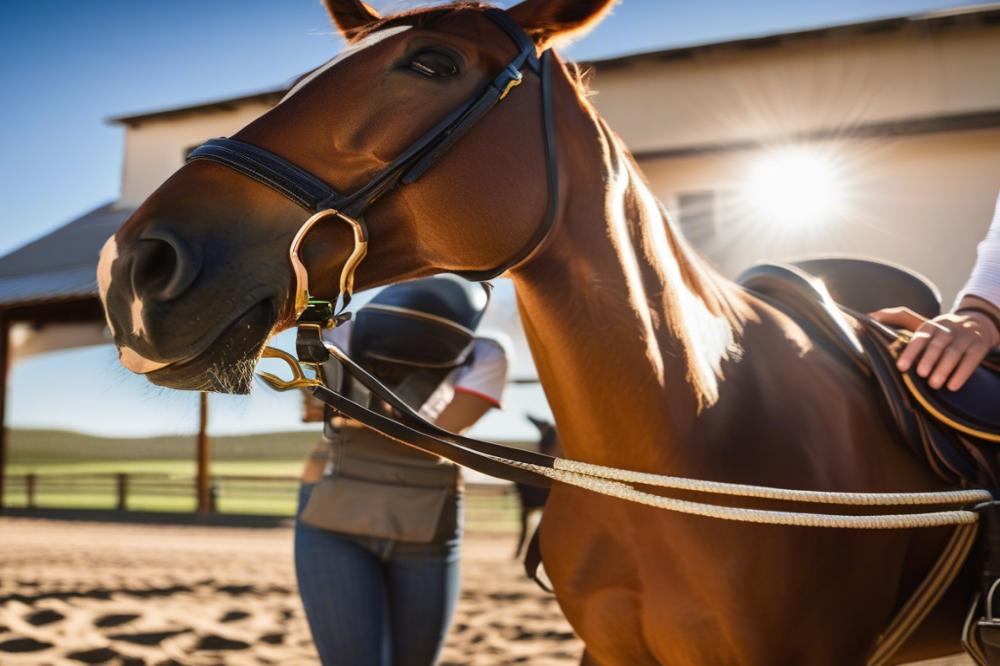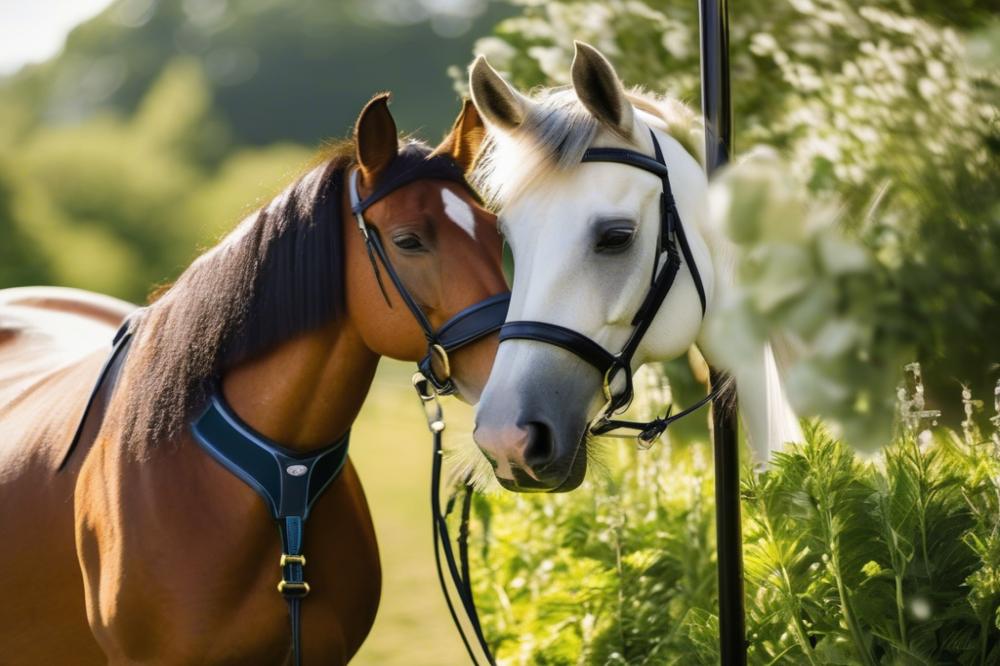The Importance of Cooling Down Your Hot Horse
After a good ride, it’s easy to look down at your horse, see the sweat glistening on its coat, and think, “Well, we did it!” But hang on a minute! Just as we humans feel the heat after an intense workout, so do our four-legged friends. Taking the time to cool down a hot horse is not just a nice-to-have; it’s a crucial part of responsible horse care.
Skipping this step can have serious consequences. You wouldn’t just jump into a cold shower right after running a marathon, would you? Neither should your horse. If you neglect proper cooling, your horse could suffer from issues like dehydration or muscle cramps. It’s like giving a car a hot rod run without letting it idle down first. Lack of cooling can even affect overall horse health down the road, and that can be a real bummer for everyone involved.
Now, let’s chat about what this article will cover. Travel with us through various equestrian techniques for horse cooling, to keep your trusty steed feeling great post-ride. We’ll dive into simple but effective ways to bring that body temperature back to normal. Whether it’s using a damp cloth, walking them around, or giving them the right drink, you’ll learn how to make post-ride care a breeze.
Oh, and just for fun—did you ever wonder, “Can a horse and a cow crossbreed?” Strange, right? But today, we’re sticking to horses and how to pamper them after a workout. After all, it’s essential to treat each horse with the kindness it deserves, and each with its unique profile. Whether your horse has an akhal teke temperament or just likes to chill after a ride, proper cooling is the key to keeping that spirit high and those hooves happy!
Understanding a Hot Horse

What Constitutes a Hot Horse
A hot horse isn’t just about temperature. It refers to a horse that has been exerted, typically after exercise or riding. When they’ve worked hard, their body heats up. Horses, like people, have different tolerances for heat. Some might feel hot after a short ride, while others can handle longer workouts. Horse care is all about recognizing when a horse truly needs cooling down.
Signs of Overheating in Horses
Noticing signs of overheating is key to maintaining equine health. A horse that’s too hot may sweat excessively or show signs of distress. Look for flared nostrils, heavy breathing, or a refusal to move. Sometimes, a horse may exhibit a rapid heart rate or become unusually quiet. You might even see them standing still and looking dazed. These indicators are warning bells you shouldn’t ignore.
Factors Contributing to a Horse’s Temperature Rise
Numerous factors can raise a horse’s temperature. The weather plays a big role, especially during hot, humid days. If your horse is not well-hydrated, this can be a problem too. Feeding practices also matter. A heavy feed before riding can lead to excess energy, which can ramp up body heat. Moreover, the type of exercise impacts temperature. Strenuous activities, like jumping or galloping, can push a horse’s temperature to unsafe levels. Understanding these elements helps with post-ride care. Being aware of them makes you a better equestrian.
Immediate Cooling Strategies

Walking your horse after riding is one of the best things you can do. It’s like a cool-down lap after gym class. Gradually letting your horse stroll allows blood flow to return to a normal state. This helps prevent muscle stiffness and supports overall equine health.
Next, consider moving to a cooler environment. Finding shade or even taking your horse into a barn can work wonders. If your riding area is sweltering, a small change in surroundings can make a big difference. The air circulation in a barn is often better, helping lower your horse’s temperature naturally.
Offering water is another essential step in horse care. Hydration plays a key role in horse health, especially after a ride. Let your horse drink at its own pace. Pouring water too quickly can cause discomfort. That’s like chugging a drink on a hot day when you haven’t had a sip for hours. Keep an eye on them; if they seem interested, keep the water flowing.
If your horse is really hot, you might want to mist them with cool water. Sprinkle some over their body, especially over their neck and legs. This can help lower their temperature without shocking their system. Remember how refreshing a splash of water can be? Horses appreciate it too!
Using a sponge can also help in this situation. Just wet it and rub it over their coat. This method can be more effective in targeted areas where heat tends to build up. A gentle rub works wonders, almost like giving them a mini-massage after a long day of work.
Ventilation is vital during this cooling process. Surrounding your horse with a soft breeze or using fans can contribute to quick cooling. Horses are big animals, and they can heat up rapidly, so a little wind can feel great. Think of it as them catching a break from the sun on a warm summer day.
Every bit helps when it comes to post-ride care for your horse. By combining walking, water, and proper environments, you enhance their comfort and health significantly. After all, you want your equine friend to feel refreshed and ready for their next adventure!
Methods for Effective Cooling

Sponging with Cool Water
Sponging off your horse with cool water is one of the best ways to help them cool down. Make sure to soak the sponge well before applying it to your horse’s body. Start at the neck and work your way down. Horses really enjoy the sensation, and it can be quite refreshing for them! Pay special attention to areas like the belly, where they might feel hot. If your horse is comfortable with it, you can even let them sip from the sponge. A little bit of water goes a long way when it comes to horse care!
Applying Ice Packs to Critical Areas
Ice packs can be a game changer for equine health post-ride. Use them on critical areas like the legs and any spots that feel particularly warm. Wrap the pack in a towel to protect the skin. Leave it on for about 15 to 20 minutes. This not only helps with cooling but also aids in reducing any inflammation. Just like we wrap ourselves in ice after a tough game, horses can benefit from the same treatment!
Using a Hose for Rinsing Off
A good rinse with a hose is another solid method to cool your horse down. Fill the hose with cool water and direct it toward the horse’s body. Start at their legs and gradually move upward. Horses really appreciate this, especially after a long ride. The water will wash off sweat while cooling their skin at the same time. Remember to be gentle around sensitive areas, and make it a pleasant experience. You might even find your horse enjoying the refreshing spray, like a kid splashing in a pool!
Monitoring Recovery
After your ride, it’s time to check in on your horse. Equine health is just as important as any thrilling ride you just had. One of the first things to do is take the horse’s temperature. You can do this with a digital thermometer. A horse’s normal temperature ranges between 99 and 101 degrees Fahrenheit. If you see a number closer to 102 or above, it might be a heads up that your buddy needs some extra care.
Next, let’s talk about respiration and heart rate. A horse’s breathing should return to normal relatively quickly after exercise. Count how many times your horse breathes in a minute. It should be around 12 to 20 breaths. If it’s significantly more than that, your horse might still be in the heat of the moment, so to speak. Similarly, check their heart rate. An average resting heart rate hovers between 28 and 44 beats per minute. If it’s racing faster than a cheetah, you know something isn’t quite right.
Now, keep an eye out for any signs that indicate successful cooling. A horse that is starting to cool will show signs of relaxation. You might notice a droopy lower lip or a softening of their muscles. If your horse is sweating less and standing quietly, that’s a good sign too. A little horsey drool wouldn’t hurt, either! This shows their body is cooling down effectively, which is excellent for horse care.
Sometimes, the things you can’t see are just as important. If they start to drink water or nibble on some hay, it shows they’re recovering well. That means their horse health is on the right track! Remember, cooling isn’t just about stopping the sweat; it’s about helping your horse recover. Equestrian techniques often emphasize the importance of a calm and easy transition. If your equine pal seems restless or anxious, it might be a cue that more cooling efforts are needed.
Long-Term Cooling Practices
Importance of Proper Conditioning
Getting a horse ready for riding isn’t just about saddling up and hitting the trails. It’s a journey of building strength and stamina. Proper conditioning is at the heart of this process. When horses are fit, their bodies handle heat better. Think of it like training for a marathon. The more prepared the horse is, the easier it will be for them to cool down afterward. Over time, a consistent routine builds muscle and endurance. Each ride becomes a step toward better equine health. Proper conditioning supports overall horse care and can make a huge difference in how quickly they return to normal after exercise.
Hydration Strategies Before and After Riding
Hydration is crucial for any horse. Before riding, offer water to keep them topped up. Sometimes, that means giving them water in small amounts to avoid a sloshy belly. After a workout, don’t forget to give them more water. Electrolyte solutions can also aid recovery. These special drinks help replace lost salts and minerals. Just like humans, horses need good hydration to keep everything running smoothly. Dehydration can lead to serious problems down the road. It’s all part of practical horse health management. Remember, a well-hydrated horse is a happy horse.
Developing a Routine for Cooling Down
Every rider wants to help their horse cool down effectively. Creating a routine makes this process easier. Start with gentle walking. This helps lower the heart rate gradually. You can also use cool water on their legs and neck, which feels refreshing. Some horses enjoy being sponged down after a ride. Engaging in such techniques promotes relaxation. Incorporating a massage can also be beneficial. Many horses love the feeling of a good rubdown after hard work. Establishing these habits not only aids in cooling but also strengthens the bond between horse and rider. Make it fun! Singing a silly song or chatting away can keep spirits high during this time.
When to Seek Veterinary Assistance
Identifying Signs of Distress
It’s important to keep an eye on your horse after riding. When a horse is too hot, it can show signs of distress. Look for excessive sweating, rapid breathing, or unusual behavior. If your horse is acting restless or trying to lie down unexpectedly, take that seriously. Drooping ears or a glazed look can also signal trouble. These signs don’t mean your horse is being dramatic—the animal could be really struggling.
Importance of Professional Evaluation for Overheating
If you notice any of these warning signs, don’t hesitate to call your vet. Ignoring these symptoms could lead to serious equine health problems. A professional evaluation is essential. Your vet can determine whether your horse is dehydrated or has overheated. They possess the knowledge to assess the situation accurately. Sometimes, horse cooling methods at home don’t suffice. Having a skillful eye on your side can make all the difference in ensuring your horse’s well-being.
Preventative Measures for Future Rides
Planning ahead is key to successful horse care. Before a ride, check the temperature and humidity. Avoid riding during the hottest parts of the day. Keeping your horse hydrated is also crucial. Offer water frequently, especially during and after exercise. Think about your horse’s fitness level, too. A horse accustomed to regular work may handle the heat better than one that isn’t. Use equestrian techniques that reduce overheating, like taking breaks in shaded areas. These simple steps can save you a trip to the vet later on.
Remember, taking care of your horse’s health starts with paying attention. Keeping a watchful eye and being proactive can keep your riding experience enjoyable and safe.
Final Thoughts on Helping Your Horse Cool Down
Taking care of a hot horse after riding is crucial for keeping your equine partner happy and healthy. After a ride, you should always remember the importance of gradual cooling. Horses work hard for us, and in return, they deserve a little extra TLC. Hydration plays a huge role—make sure to offer water frequently. An easy way to start cooling down is by walking them for 10 to 15 minutes. This helps bring their heart rate back to a safe level.
It’s also good practice to monitor their temperature regularly. A horse’s body temperature can skyrocket, especially after a challenging ride, so being aware can prevent any nasty surprises. Don’t forget to check their pulses too. These simple checks go a long way in ensuring their well-being. When it comes to cooling methods, remember that using cool towels or sponge baths can be refreshing but should be done carefully to avoid shock.
Moreover, be mindful of your horse’s condition. A horse that gets too hot could be showing signs of distress or overexertion. Treat your horse like a true friend. Just as you wouldn’t want your best mate to struggle, the same goes for your ride buddy. Whether you’re cruising down the trail in english riding vs western style, safety should remain a top priority.
Ultimately, responsible horse riding encompasses more than just enjoying the ride. It’s about understanding your horse’s needs and responding accordingly. Remember, even the best of horses might need a little help to cool off, just like a long day at work may call for ice cream. And speaking of unique pairs, did you know that a horse and pony can become friends, even to the point that they might horse mate with pony instincts? Just goes to show that every ride is an adventure and that each horse deserves attention and love.
As you wrap up your riding session, think about the importance of creating a cooling routine. Work on making the cooling-down process part of your ride, ensuring your horse leaves the arena feeling as good as they look. Follow these steps, and you’ll build a great relationship with your horse while also keeping their health in check. Happy riding!



